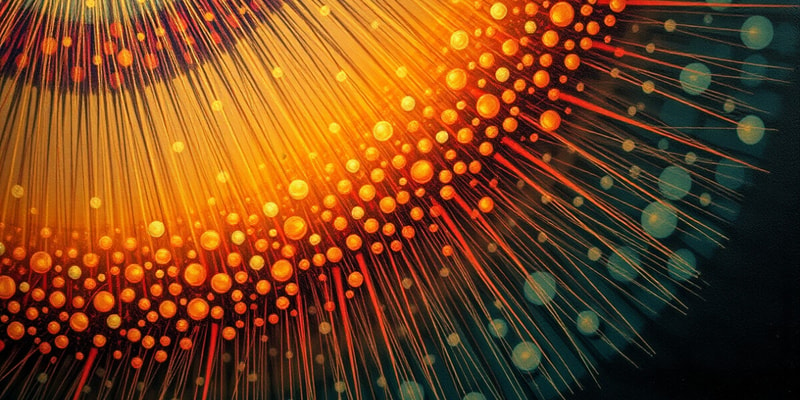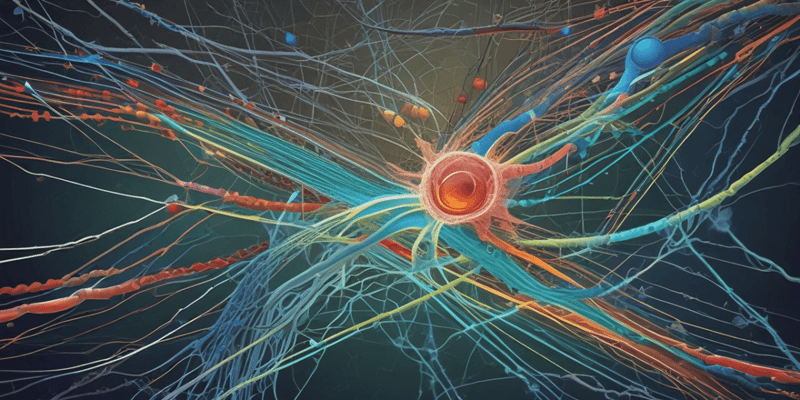Questions and Answers
Cilia and flagella share the same axonemal structure of 9+2 m’tubules, which is essential for their movement.
True
The drug Vincristine acts by enhancing the polymerization of m’tubules during cell division.
False
Microtubules are unstable structures that frequently break down and reassemble during cell division.
False
The anchoring of the axoneme in the plasma membrane occurs through a structure known as the basal body.
Signup and view all the answers
The centrosome is composed of three centrioles.
Signup and view all the answers
M’tubule inhibitors, like Taxol, facilitate chromosomal separation by promoting m’tubule disassembly.
Signup and view all the answers
Microtubule assembly occurs primarily at the plus end.
Signup and view all the answers
Disassembly of microtubules mainly occurs from the minus end.
Signup and view all the answers
Cytoplasmic dynein is responsible for anterograde transport of organelles.
Signup and view all the answers
Dynamic instability of microtubules is characterized by the simultaneous growth and shrinkage of microtubules.
Signup and view all the answers
In cystic fibrosis, cilia function is enhanced due to increased microtubule stability.
Signup and view all the answers
The presence of GTP at the plus end of a microtubule inhibits assembly.
Signup and view all the answers
Keratins are a type of microtubule found in the cytosol of epithelial cells.
Signup and view all the answers
Intermediate filaments require ATP for polymerization.
Signup and view all the answers
Desmosomes facilitate strong adhesion between adjacent epithelial cells.
Signup and view all the answers
Neurofilaments play a crucial role in providing structural support to nerve cell axons.
Signup and view all the answers
Vimentin is primarily found in the nuclei of epithelial cells.
Signup and view all the answers
Epidermolysis Bullosa simplex is associated with defects in keratins.
Signup and view all the answers
Cellular polarity is a characteristic feature of intermediate filaments.
Signup and view all the answers
Amyotrophic Lateral Sclerosis (ALS) is primarily caused by defects in actin filaments.
Signup and view all the answers
The vimentin family includes desmin and is found in mesenchymal cells.
Signup and view all the answers
Fluid shear stress is a significant factor in contracting skeletal muscles.
Signup and view all the answers
Study Notes
Assembly of Microtubules
- Centrosome is composed of two centrioles and acts as a microtubule-organizing center.
- The minus end of microtubules is capped at the centrosome complex during microtubule elongation.
- Tubulin subunits, bound to GTP, add to the plus end of microtubules, promoting growth.
- GTP bound to β-tubulin is hydrolyzed to GDP, influencing microtubule stability.
Dynamic Instability
- Microtubules exhibit dynamic instability characterized by rapid growth and shrinkage.
- Disassembly of microtubules occurs primarily from the plus end.
- Capping proteins at the plus end can prevent disassembly, stabilizing microtubules.
Vesicle and Organelle Transport
- Transport of intracellular components requires energy in the form of ATP.
- Microtubule motor proteins, such as kinesin (anterograde transport) and dynein (retrograde transport), facilitate vesicle movement.
Movement of Cilia and Flagella
- Cilia line respiratory tracts to clear mucus; flagella enable sperm motility.
- Axonemes consist of a 9+2 arrangement of microtubules and are anchored in the plasma membrane.
- Dynein, an ATPase, is essential for the motility of cilia and flagella.
Intermediate Filaments (IFs)
- Major IFs include keratins, vimentins (including desmin), neurofilaments, and lamins.
- Epithelial IFs serve to stabilize cell connections at desmosomes, which adhere adjacent cells together.
- Keratins provide structural integrity to epithelial cells, connecting to the extracellular matrix.
Neurofilaments
- Neurofilaments in axons provide structural support, helping to resist breakage along the nerve cell's length.
Cystic Fibrosis Context
- Cystic fibrosis (CF) is a genetic disorder causing respiratory complications due to malfunctioning cilia.
- This condition is characterized by high levels of chloride in sweat and recurrent respiratory infections.
Mitosis and Microtubule Dynamics
- During interphase, centrosomes duplicate and microtubules disassemble, preparing for cell division.
- Microtubules orient the spindle during cell mitosis, facilitating chromosome separation into daughter cells.
Microtubules in Clinical Medicine
- Microtubule inhibitors, such as Taxol (blocks disassembly) and Vincristine (prevents polymerization), are used in cancer chemotherapy to disrupt cell division.
Learning Objectives
- Differentiate the locations and functions of cytoskeletal components and their binding proteins.
- Understand the molecular mechanisms of polymerization and depolymerization of cytoskeletal elements.
Studying That Suits You
Use AI to generate personalized quizzes and flashcards to suit your learning preferences.
Description
Explore the fundamental concepts of microtubules and centrosomes as discussed in cell biology. This quiz will test your understanding of dynamic instability, tubulin subunits, and the role of the centrosome in microtubule elongation. Enhance your knowledge on these critical cellular structures and their functions.




